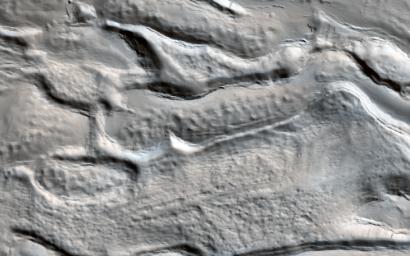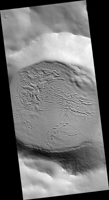
|
Icy Flow in a Crater
- Click the image above for a larger view
- Full-Res JPEG (2880 x 1800) (567.3 kB)
- Full-Res TIFF (2880 x 1800) (15.1 MB)
Caption:

Map Projected Browse Image
Click on the image for larger version
The material on the floor of this crater appears to have flowed like ice, and contains pits that might result from sublimation of subsurface ice. The surface is entirely dust-covered today. There probably was ice here sometime in the past, but could it persist at some depth?
This crater is at latitude 26 degrees north, and near-surface ice at this latitude (rather than further toward one of the poles) could be a valuable resource for future human exploration. A future orbiter with a special kind of radar instrument could answer the question of whether or not there is shallow ice at low latitudes on Mars.
The map is projected here at a scale of 50 centimeters (19.7 inches) per pixel. [The original image scale is 57.5 centimeters (22.6 inches) per pixel (with 2 x 2 binning); objects on the order of 172 centimeters (67.7 inches) across are resolved.] North is up.
Background Info:
The University of Arizona, Tucson, operates HiRISE, which was built by Ball Aerospace & Technologies Corp., Boulder, Colo. NASA's Jet Propulsion Laboratory, a division of Caltech in Pasadena, California, manages the Mars Reconnaissance Orbiter Project for NASA's Science Mission Directorate, Washington.
Cataloging Keywords:
| Name | Value | Additional Values |
|---|---|---|
| Target | Mars | |
| System | ||
| Target Type | Planet | |
| Mission | Mars Reconnaissance Orbiter (MRO) | |
| Instrument Host | Mars Reconnaissance Orbiter | |
| Host Type | Orbiter | |
| Instrument | High Resolution Imaging Science Experiment (HiRISE) | |
| Detector | ||
| Extra Keywords | Color, Crater, Dust, Map, Radar | |
| Acquisition Date | ||
| Release Date | 2017-03-08 | |
| Date in Caption | ||
| Image Credit | NASA/JPL-Caltech/Univ. of Arizona | |
| Source | photojournal.jpl.nasa.gov/catalog/PIA21556 | |
| Identifier | PIA21556 | |
